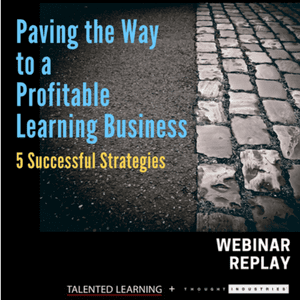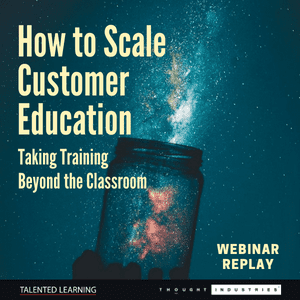
Podcast: Play in new window | Download
Subscribe: Apple Podcasts | Spotify | Amazon Music | Android | iHeartRadio | Blubrry | Email | RSS
EPISODE 25 – TOPIC SUMMARY AND GUEST:
If you’re familiar with our organization, you know that extended enterprise learning is at the heart of everything we do. That’s why I’m especially excited to explore today’s topic with Doug Gastich. Doug is President of BlueVolt, a true pioneer in channel training innovation, and a unique example of extended enterprise learning in action. This interview offers useful insights for every results-oriented learning professional, even if your organization doesn’t sell through channel partners.
KEY TAKEAWAYS:
- Channel sales professionals have very unique learning needs that standalone employee learning systems aren’t designed to fulfill.
- Incentives can be a highly effective way to engage voluntary learners in educational programs. But typical gamification techniques, alone, may not be sufficient.
- Some organizations invest in channel training as a necessary cost of doing business. Yet metrics prove that channel training has a significant impact on sales performance.
Q&A HIGHLIGHTS:
How would you describe BlueVolt’s unique spot in the extended enterprise learning market?
It’s funny. If we were to use the term “extended enterprise” with our customers, people would probably look at us like we have three heads.
But our mission is to help businesses build culture, grow sales and gain brand loyalty. And we do that by educating their extended sales and distribution network. So the idea of extended enterprise education hits home for us. That’s what we’re all about.
What’s unique about your channel training solution that helps companies achieve this?
BlueVolt is a little different from other LMS solutions because it comes with a built-in course-sharing network to reach learners both inside and outside the walls of our customers’ organizations – wherever they need to be. And it’s also designed from the ground up to deliver elearning content from wherever it may be located.
How did you come to specialize in learning for the skilled trades industry?
We now serve a variety of industries, but initially, our focus was channel training for the skilled trades. You could also call it manufacturing and distribution.
Think of it as organizations that make products for industrial, retail or commercial building or maintenance. It also includes companies that sell, use or apply those kinds of products.
So what led you down the channel training path?
Well, 30 years ago before digital learning was a realistic option, electrical distributors often educated branch managers and sales associates by shipping binders filled with learning materials all over the country.
Yikes…
Then about 17 years ago, one of the nation’s premier electrical distributors decided there had to be a better way, and that’s when BlueVolt was born. We digitized that whole process and created an LMS to support it. Back then, LMSs were just getting started. Some of the early players were around and software-as-a-service was not even a thing yet.
Yep. I remember those days…
But we decided from the beginning that BlueVolt would be a software-as-a-service (SaaS) online learning platform. This was a challenge because it needed to fit into the manufacturing and distribution world, which is built on relationships. It’s all about that human touch. So whatever we did had to be simple and easy. It had to augment what existed – not necessarily replace it.
So you developed your channel partner network, which is a broad ecosystem, rather than a company-by-company deployment. Is that right?
That’s right. And that’s very intentional. BlueVolt is built from the ground-up as a multi-tenant SaaS application. So if needed, we can create all the virtual walls you may need to protect your learners and content from outside eyes. But our core philosophy is the opposite.
On the one hand, manufacturers need to control communication. For example, you don’t want people on the East Coast to receive information about a particular heater if they never use that product. But generally speaking, if you’re a manufacturer, you want to share information broadly and consistently.
That’s exactly what our ecosystem is designed to do. It’s meant to be a comprehensive library of product materials. But we don’t work with everyone in the world – yet.
So how do you fill the content gaps?
If needed, we’ll facilitate relationships. For example, after looking at our channel training catalog, a new customer may say, “We work with 15 companies in your library, so include that content in our LMS. Plus, we carry these four lines from ABC Company, and we want their content, too.” They might be able to snag the additional content directly, or we can help make the connection.
Next, they may say, “Here are 20 other companies we want to work with.” In that case, they can use the same tools we do to connect with those sources and pull content directly into their system.
Interesting…
So in short, our platform includes a toolset that makes it possible to share and syndicate product content. We use those tools every day to expand and update our library, which is always available and ready to go. And many of our customers use those very same admin tools to expand their own course library from their particular suppliers and other sources all over the world.
Cool. So tell me, what makes effective channel training programs work?
Well, first here’s a little trick, John. Tell me, who was your favorite teacher?
Easy. Mrs. Martin, my 2nd-grade teacher.
Okay, now what’s the name of the person who sold you your last a car?
No idea.
Exactly! We work mostly with salespeople and marketers, right? There’s nothing bad about them. But when you can actually teach someone something, you’re going to find a special place in that person’s brain that’s far different from the latest sell sheet or other marketing materials. You’re going to develop a loyal connection that you just can’t get any other way.
They may not be able to remember the name of a company’s product manager, like you can remember Mrs. Martin. But they’re definitely going to remember that the product manager taught them how to serve their customers better and add value on-the-spot in what can sometimes be a tense or nerve-wracking situation.
That’s what we mean by building culture, mind share and brand loyalty.
Excellent. So, could you walk me through an example?
Sure. Many people are familiar with industrial supply. Think of tools, fasteners – the hardware products you find at a retailer like Lowe’s or Home Depot.
It also includes highly specialized products like fasteners that tie big bolts into cement. The same few companies make a wide variety of those products.
Got it.
Now, let’s say one of these companies produces the world’s longest-lasting drill bit. There will always be something about a product that is special and deserves to be understood by end customers and everyone in the supply chain.
But here’s the challenge. Very few of these manufacturers sell directly. Some do, but most sell through representatives. That could include distributors, retailers, or whole companies with branches that sell to end customers. And these intermediaries represent multiple product lines.
So selling the world’s best drill bit is like a game of telephone. It starts with the manufacturer’s product manager, who knows this drill bit can make a customer’s line employees 10x more efficient because they won’t change bits as often, they’ll get a cleaner cut and they won’t require rework. This drill bit really is awesome.
Right…
The product manager gets it, and he trains the channel salesperson in his company. But that’s just the start. You’ve also got a counter person and an inside sales rep at a distributor, who will sell 5000 of these drill bits to a contractor that’s building one of the area’s next great skyscrapers.
How do you make sure that the buyer on the project site knows why your drill bit will save him $10,000 over the next 8 months? That’s the challenge we’re solving through channel training.
I see.
The idea is that you can take that knowledge and share it in chunks, over time. That may look and smell like marketing. But it goes deeper.
If you can teach customers at the point of sale why your product is better for them, you can move mountains. Not only will you make the original sale, but those customers will also remain loyal to you because you’ve taught them something really useful.
Should we assume that the person who sells 5000 drill bits to the ultimate buyer is also selling many lines of many products to many different buyers?
Yeah. They may represent 10-20 manufacturers, with 40 or more products from any one of those companies. So they may need to know about hundreds or thousands of products. Maybe even tens of thousands. It’s insane.
Wow. So how do you win their mind share?
It can be tough. Focus helps. For example, our product includes a tool called Training Tracks. It’s a very basic way to create education playlists.
We encourage people to use this tool when curating channel training content. For example, let’s say the rainy season is approaching. You can develop a storyline that focuses on using flashing in a particular type of application to waterproof a house.
In other words, you can design a learning experience that makes product differentiation relevant to a specific customer need. It’s marketing 101 stuff. But this approach brings it home with channel training that gains mind share. It helps you hook into someone’s brain.
Makes sense.
Of course, you also need to consider all the basics of learning and development, too. Right? You have to keep it simple. You have to create some sort of novel interaction.
A story is extremely helpful. You can provide incentives to take the training. That goes a long way to get learners interested.
No doubt. So let’s talk about incentives. You have a very special approach…
Yeah, we call it $BlueBucks. It’s a points program that’s simple but effective. And learners love it.
You earn dollar-for-dollar $BlueBucks rewards for completing learning activities. For example, you receive 1-5 points for completing a course. Rewards usually are funded by the manufacturer or supplier that produces the course, or by your employer.
It’s better when $BlueBucks are reserved for important content. But the idea is that, over time, when a learner completes 4-6 of these special courses, they’ll have enough $BlueBucks for a gift card to a local restaurant.
I’ve seen gamification in learning environments, but nothing quite like this.
We’ve actually added some more traditional gamification tools – leaderboards and contests. But this program is still the most effective at building learner participation.
It’s interesting because we never thought of it as gamification. But it does make product training much more like a fun challenge.
Seems like a smart strategy for channel training.
It’s been a really effective way for us to get folks interested. It took off like wildfire and never really stopped. In fact, it’s so effective, we’ve actually expanded it. So now you can redeem points for manufacturers’ swag – hats and products – in addition to gift cards.
So to summarize, gamification on its own is fine. But when it leads to something meaningful, that’s so much better – especially for voluntary learners.
Right. Especially when people are busy at work, they struggle to find time for optional product education.
Think about it. You’re a manufacturer and you rely upon people at another company to sell your stuff. They’re not on your payroll. You can’t tell them what to do. So how do you get that channel partner’s employees charged-up and interested?
Well, step one is to put something useful in front of them. But a very effective step two is incentives that get them involved. Make it fun.
So, how do channel training programs convince management that this works?
That’s a really good question. Of course, our platform has everything you need to measure interest, enrollments and completions. But the real data isn’t in our system. The real data is in product purchasing and customer success. It’s in employee attrition and happiness.
Actually, I just had the ROI conversation with a customer that is all-in on this training. I asked him about the value they’re getting and how they measure it. And he said, “What do you mean?”
Because for them, channel training is a given. It’s an article of faith that they must offer this education.
Interesting…
So then I asked, “If we could give you the perfect ROI study linking levels of training with revenue per branch, what would you do with that?”
He said, “I wouldn’t even look at it. We know we need to do this. We’re heads down, and I’m not going to take time worrying about exactly where it went.”
Really?
Now that’s one end of the metrics spectrum. On the other end, a lot of our distributors are concerned about employee retention. So, they’re trying to determine if there’s a correlation with training involvement. And they’re finding that the more time people spend in a learning program, the less likely they are to leave.
You can also determine that without employees actually leaving a distributor. They’ll run a 90-day employee training report to see how much onboarding new employees have completed. And they can see red flags right away.
No doubt.
We’ve actually stumbled upon some pretty hard numbers here that reveal a lot. One of our partners is a purchasing cooperative. In other words, they connect buyers and sellers in our world. They run a university through BlueVolt and they’ve looked at buying and selling activity.
They split their user base into five groups, based on how many courses they completed per-person. And the top three groups are consistently growing purchasing volume in their group by over 60%.
Meanwhile, in the bottom two groups, there was a sharp fall-off in purchasing. A few were between 1-9% growth, year over year, while most had almost zero growth.
Wow…
So channel training really works. And you can measure it. Granted, measurement takes a lot of work. But when you do, you’ll see that by developing a habit of training – it doesn’t even take a lot – you can raise the sales bar across your organization…





